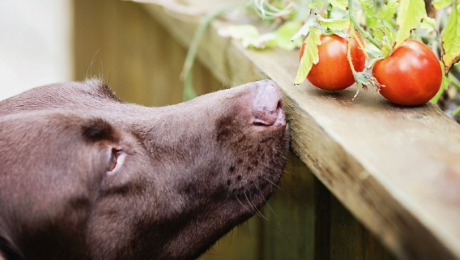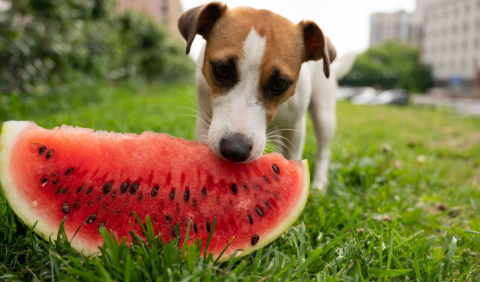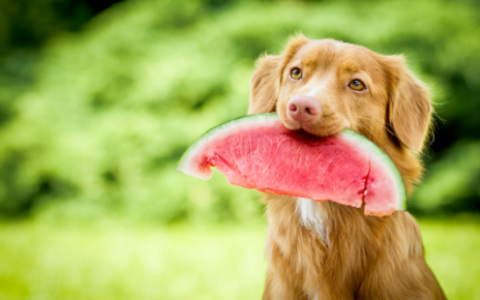Once your dogs ingest tomatoes in large quantities, they may show symptoms when they are experiencing tomatine poisoning. Gastrointestinal upset is the most common symptom of tomato poisoning in your dogs. If you see this symptom in your dogs, taking your dog to a vet is a must.
However, the Gastrointestinal upset is not only one symptom of tomato poisoning in dogs, instead there are other symptoms of tomato poisoning that your dogs show. To know all the symptoms of tomato poisoning, you can dive into our post below!

Symptoms of Tomato Poisoning
Even though tomatine poisoning is rare in your dogs and commonly is not fatal, identifying the symptoms of tomato poisoning is a must for you. After seeing and knowing the symptoms of tomato poisoning, you can do the next steps in treating your dog.
Here are the following symptoms of tomato Poisoning:
-
- Hypersalivation
- Loss of coordination
- Loss of appetite
- Gastrointestinal upset
- Vomiting
- Diarrhea
- Confusion
- Drowsiness
- Behavioral change
- Weakness
- CNS depression
- Dilated pupil
- Abnormal heart rate
- Tremors
- Seizures
- Lethargy
- Abdominal pain
- Cardiac effects (arrhythmia, irregular heartbeats)
- Gastrointestinal upset (diarrhea, vomiting)
Those are the symptoms of tomato poisoning that your dogs are experiencing. Thankfully, this kind of reaction is rare and poisoning can be treatable. Your dog may need to eat large amounts of stems and leaves of the tomato to get seriously ill.
However, minor symptoms including gastrointestinal distress, may occur from even small amounts. If your dogs have ingested green tomatoes or tomato stems or leaves, particularly in large quantities, you should pay attention to them and call your vet to be safe.
If your dogs show any of the above symptoms, please go to the emergency vet right away. However, some dogs probably show an allergic reaction to tomatoes, but again, it is quite rare. In this case, an allergic reaction can manifest as coughing, hives, swelling, wheezing or difficulty breathing.
It’s important to note, a large amount of the green parts of the tomato plant typically needs to be ingested to cause toxicity symptoms. It may only take a small amount to result in toxicity if you have a small dog or puppy.
Causes of Tomato Poisoning in Dogs
Tomatoes are not always healthy for your dogs, instead they can trigger any unwanted things, one of them is tomato poisoning. Tomatoes contain a potentially toxic substance called tomatine, causing your dog to get tomato poisoning.
Tomato poisoning happens when your dogs ingest the unripe tomato and any part of the green foliage. However, tomato plants generate the toxin solanine that primarily causes irritation of the stomach and intestinal lining resulting in gastrointestinal upset.
Even though tomatoes only contain such a small amount rather than the leafy greens, if consumed in large quantities, it will trigger tomato poisoning in your dogs. Well, the concentration of tomatine will increase rapidly when the tomatoes ripen.
The clinical signs may include gastrointestinal, weakness and ataxia if stems, vines and green fruit are ingested. Well, the best way to recover your dogs is through treatment with an overall good prognosis. In most cases, mild gastrointestinal upset likely happens when your dogs eat tomato greenery.
It is known that there are different species of tomatoes, but all are similar in appearance. Need to know, tomatoes belong to the Solanine family and the genus Lycopersicon. Most people will grow tomatoes in their home garden, greenhouses or in a large field.
Furthermore, tomatoes can also be used in a lot of recipes, but commonly the ripened fruit is used, not the green unripe fruit. If you grow tomatoes in your garden, you need to make sure your dog does not have access to the growing plant.
Diagnosis of Tomato Poisoning in Dogs
After taking your dogs to the vet for tomato poisoning treatment, the vet may begin by doing a physical examination on your dogs to assess your dog’s symptoms at present and note any abnormalities of his vitals.
If your dogs are drooling excessively or showing other symptoms of oral pain, your vet may take special treatment when examining your dog’s mouth to note any abnormalities. If your dogs vomit while at the clinic, the vet will examine the contents for any evidence as to what your dog ingested. If your dog experiences diarrhea, a fecal sample can be taken and tests done to get rid of internal parasites or bacterial overgrowth.
Your vet will also perform a blood examination to give a broad look as to how the internal organs are functioning. In this case, a complete blood count (CBC) and chemistry panel will really provide the vet with needed information for appropriate assessment.
Hereafter, your vet may perform a packed cell volume (PCV) to determine hydration status. If your vet feels it is needed, she/he will do a urinalysis for further evaluation of kidney function.
Your vet will also perform an ECG if your dog experiences some type of cardiac related symptoms in order to get a current reading of your dog’s pulse and to make sure each part of the heart is properly functioning.
If you believe or witness your dog ingesting this plant, you can take a piece of it with you to the vet. However, it will support appropriate identification of the plant that your dog ingested and the toxin it contains.
If your dogs are showing severe symptoms of toxicity, make sure to consider if the tomato was treated with weed killer or fertilizer or if the dog probably has ingested something else that is more toxic.
Tomato Poisoning Treatment
Tomato poisoning treatment can only be performed by the veterinarian. The vet will do administration of fluid therapy with electrolytes if your dogs are vomiting and having diarrhea. This way is to help the body flush the toxin out faster.
Furthermore, the veterinarian will also induce vomiting to allow your dogs to expel any remaining pieces of tomato plant. The vet will then administer activated charcoal to bind any remaining toxin from the stomach before the body absorbs it.






